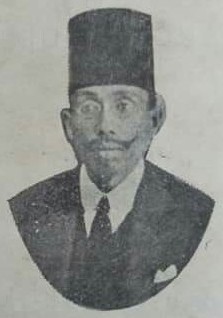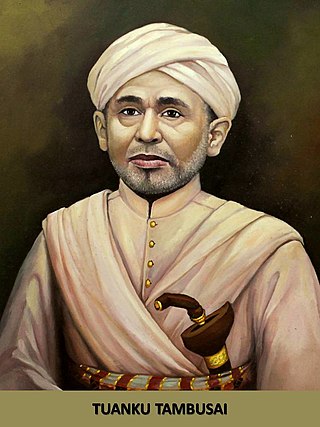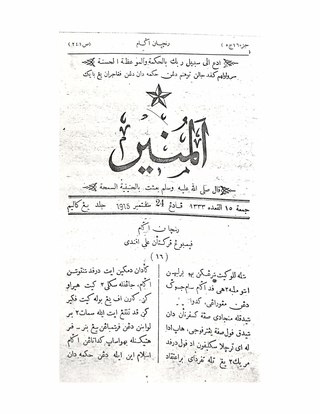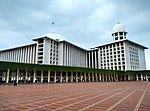Related Research Articles

Tuanku Imam Bonjol, also known as Muhammad Syahab, Peto Syarif, and Malim Basa, was one of the most popular leaders of the Padri movement in Central Sumatra. He was declared a National Hero of Indonesia.

Minangkabau people, also known as Minang, are an Austronesian ethnic group native to the Minangkabau Highlands of West Sumatra, Indonesia. The Minangkabau's West Sumatera homelands was the seat of the Pagaruyung Kingdom, believed by early historians to have been the cradle of the Malay race, and the location of the Padri War.

The Padri War was fought from 1803 until 1837 in West Sumatra, Indonesia between the Padri and the Adat. The Padri were Muslim clerics from Sumatra who wanted to impose Sharia in Minangkabau in West Sumatra, Indonesia. The Adat comprised the Minangkabau nobility and traditional chiefs. They asked for the help of the Dutch, who intervened in 1821 and helped the nobility defeat the Padri faction.

West Sumatra is a province of Indonesia. It is on the west coast of the island of Sumatra and includes the Mentawai Islands off that coast. West Sumatra borders the Indian Ocean to the west, as well as the provinces of North Sumatra to the north, Riau to the northeast, Jambi to the southeast, and Bengkulu to the south. The province has an area of 42,119.54 km2 (16,262.45 sq mi), with a population of 5,534,472 at the 2020 census. The official estimate at mid 2022 was 5,640,629. The province is subdivided into twelve regencies and seven cities. It has relatively more cities than other provinces outside Java, although several of them are relatively low in population compared with cities elsewhere in Indonesia. Padang is the province's capital and largest city.

Pagaruyung, also known as Pagarruyung, Pagar Ruyung and Malayapura or Malayupura, was a kingdom that once stood in the island of Sumatra and the seat of the Minangkabau kings of Western Sumatra. Modern Pagaruyung is a village in Tanjung Emas subdistrict, Tanah Datar regency, located near the town of Batusangkar, Indonesia.

Fort van der Capellen is a small 19th-century Dutch fort in Batusangkar, West Sumatra, Indonesia. The town of Batusangkar grew considerably around the Fort van der Capellen. The fort was named after the Governor-General of the Dutch East Indies Godert van der Capellen.

Abdul Karim Amrullah, known as Haji Rasul, was a Muslim reformer who led reformation of Islam in Sumatra, Dutch East Indies.

A surau is an Islamic assembly building in some regions of Sumatra and the Malay Peninsula used for worship and religious instruction. Generally smaller physical structures, its ritual functions are similar to a mosque, allow men and women, and are used more for religious instruction and festive prayers. They depend more on grassroots support and funding. They can be compared to the Arab zawiya. In Minangkabau society, they continued pre-Islamic traditions of a men's house, and are built on high posts.
Muhammad Amrullah Tuanku Muhammad Abdullah Saleh also known as Tuanku Kisai, was a great scholar of Minangkabau and an ancestor of two major figures in the Malay world. One man is his own son, Abdul Karim Amrullah, and another is his grandson, Hamka. His grandfather was Tuanku Nan Tuo, one of the prime movers of the Padri in West Sumatra.

Sheikh Haji Muhammad Saleh, better known as Tuanku Tambusai, was an Islamic leader in the Padri movement. He fought the Adat and Dutch colonists during the Padri Wars in 1838, along with his contemporaries, Tuanku Imam Bonjol and Tuanku Rao.

Mahmud Yunus was an Indonesian Minangkabau Islamic preacher and teacher. He authored over seventy-five books, including Tafsir Qur'an Karim and an Arab-Indonesian dictionary. His books are used in madarsas and pesantrens. During his employment in the Indonesian Department of Religion, he promoted the incorporation of religious lessons into the national education curriculum. Yunus received an Honorary Doctorate in "tarbiyah" from IAIN Syarif Hidayatullah, Jakarta. A road to IAIN Imam Bonjol, Padang is named after him.

Islam is the most common religion in the Indonesian province of West Sumatra, embraced by 97.42% of the population. The Muslim population increases to 99.6% if it excludes the Mentawai Islands, where the majority of the non-Muslim (Protestant) West Sumatrans reside. Islam in West Sumatra is predominantly Sunni, though there is a small Shia Islamic pocket within the coastal city of Pariaman. The Minangkabau people, indigenous to West Sumatra, comprise 88% of the West Sumatran population today and have historically played an important role within Indonesia's Muslim community. Up until today, the region is considered one of the strongholds of Islam in Indonesia.
Tuanku Nan Tuo (1723–1830) or Tuan Ku Nan Tua was one of the leading Minangkabau ulamas. He was known as a wasatiyyah (moderate) cleric, who took syncretic approaches in the religious outlook, and was a Sufi and aspired for reformation and purification of Islam in the Agam region of West Sumatra at the same time. He also played a crucial role in the birth of Minangkabau Islamic reformers known as padri. Tuo however, disagreed with the more radically puritanical views espoused by padris including Tuanku Nan Renceh and Tuanku Imam Bonjol.

Al-Munir was an Islamic magazine, written in Arabic-Malay, published in Padang from 1911 until 1915. Inaugurated by the initiative of Abdullah Ahmad in early April 1911, Al-Munir was listed as the first Islamic mass media in Indonesia. The magazine was often associated with Al-Imam magazine published under the direction of Sheikh Tahir Jalaluddin in Singapore during 1906-1909. In addition to Abdullah Ahmad, several religious figures such as Abdul Karim Amrullah, Muhammad Thaib Umar and Sutan Muhammad Salim were recorded in the ranks of the editorial board.

Tuanku Nan Renceh was an Islamic cleric (ulama), leader and commanding figure highly regarded in Indonesia as a fighter against the Dutch colonialism in the battle known as the Padri War from 1803-1838. Not much is known about this figure, other than his charismatic status. He is also known for his commitment to upholding the Shari'a. From the Dutch record, he was considered an antagonist figure, who was responsible for the violence in the Plateau of Padang.
Sumatera Thawalib was one of the earliest Islamic mass organizations in Indonesia, based in West Sumatra. Sumatera Thawalib represented the modernist school of Islam in Indonesia, an Islamic reform with heavy emphasis on the Qur'an, hadith, a modern scientific education, and abolishing of non-orthodoxy. Islamic Modernism was promoted by Muhammad Abduh. The term Sumatera Thawalib literally means "Students of Sumatra", and it was founded on January 15, 1919 as a result of meeting between the Muslim students of Padang Panjang, Parabek and Padang Japang. The aim of the organization was deepening of Islamic knowledge among the Muslim students. The organization had contributed substantially to the development of Islam in West Sumatra in the early 20th century.
Tuanku Pasaman was an Islamic cleric (ulama) and leader. He was known as a prominent padri, a group of Islamic reformists who advocated for the puritanical approach in Islam inspired by Muhammad ibn Abd al-Wahhab in the early 18th century West Sumatra. There is not much data available for this figure, except for his role during the Padri War.

Union of Islamic Education, also known as PERTI, is a Shafii-Ash'ari Islamic organization in Indonesia. The organization was founded by Sulaiman ar-Rasuli on May 5, 1928 in Candung, West Sumatra. In its development, PERTI had become a political party and gained four People's Representative Council (DPR-RI) seats and seven Constituent seats in 1955 general election.

Sheikh Sulaiman ar-Rasuli, known as Inyiak Canduang, was an Indonesian ʿālim and founder of Union of Islamic Education, a kaum tua (traditionalist) Islamic organization from West Sumatra. He was credited for popularizing the famous Minangkabau idiom, adat basandi syarak, syarak basandi Kitabullah.
References
- ↑ Marjohan, Mempertimbangkan Kepahlawanan Tuanku Rao, Padang Today, 2-4-2009.
- ↑ Hamka, Antara Fakta Dan Khayal :Tuanku Rao, 1974: pp.110-112,156-157.
- 1 2 Muhammad Radjab, Perang Paderi di Sumatera Barat (1803-1838), Balai Pusataka, 1964. pp.164-166.
- ↑ Hadler, Jeffrey. A Historiography of Violence and the Secular State in Indonesia: Tuanku Imam Bondjol and the Uses of History. The Journal of Asian Studies, Vol. 67, No. 3 (August) 2008: 971–1010. pp.982
- ↑ Rusli Amran and the Rewriting of Minangkabau History. Kyoto Review. Retrieved November 28, 2017.
